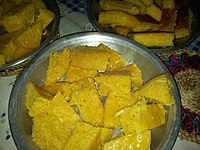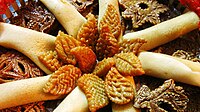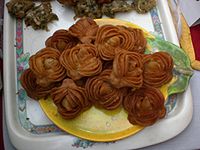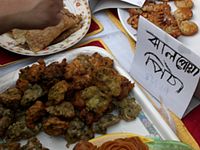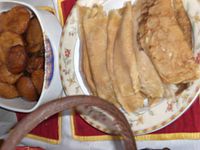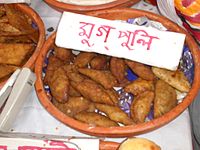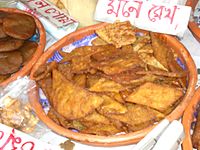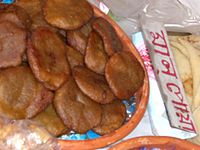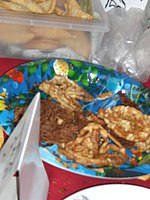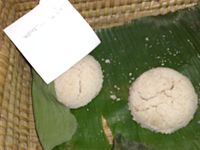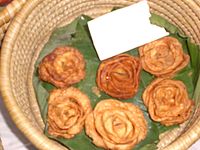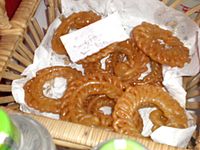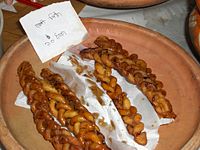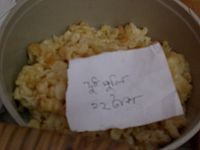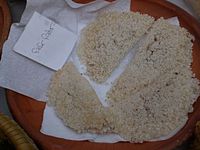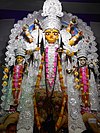Pitha
This article needs additional citations for verification. (April 2020) |
 Bengali Chitoi Pitha | |
| Course | Whole meal, snack or dessert |
|---|---|
| Place of origin | Indian subcontinent |
| Region or state | Assam, Bihar, Jharkhand, Kerala, Odisha, Tripura, West Bengal |
| Associated cuisine | India, Bangladesh, Nepal |
| Main ingredients | Rice flour or wheat flour |
Pitha is a type of rice cake from the eastern regions of the Indian subcontinent, common in Bangladesh, Nepal and India. It is especially popular in the eastern Indian states of Bihar, Jharkhand, Odisha, West Bengal, the South Indian state of Kerala, and the Northeast Indian states, especially Assam. Pithas are typically made of rice flour, although there are some types of pitha made of wheat flour. Less common types of pitha are made of palm or ol (a local root vegetable).
Preparation
Pithas are primarily made from a batter of rice flour or wheat flour, which is shaped and optionally filled with sweet or savory ingredients. When filled, the pitha's pouch is called a khol (literally "container") and the fillings are called pur.
For stuffed vegetable pithas, ingredients such as cauliflower, cabbage, radish, or potato are usually fried, baked, or steamed, and then mashed, cooled, and formed into small balls to stuff into the pithas.
Sweet pithas typically contain sugar, jaggery, date juice, or palm syrup, and can be filled with grated coconut, fried or roasted sesame seeds, cashews, pistachios, sweetened vegetables, or fruits. Sweet pithas are also often flavored using cardamom or camphor.
Depending on the type of pitha being prepared, pithas can be fried in oil or ghee, slow-roasted over a fire, steamed, or baked and rolled over a hot plate.
Pithas are often eaten during breakfast, as a snack with (often with tea), and in dinner or lunch. Although there are many sweet varieties that are reserved for desserts or holidays.
Regional variation
Pithas vary considerably across the regions of the eastern Indian subcontinent.
In Assam
In Assam, pitha is a special class of rice preparation generally made only on special occasions like Bihu. Assamese pithas are often made from bora saul, a special kind of glutinous rice, or xaali saul, or sun-dried rice. Some pithas commonly found in Assam include the following:
- কাঁচি পিঠা Kachi pitha (lit. "Sickle pitha"): a pan baked pancake made from bora saul and filled with sesame seeds, ground coconut, dried orange rind, and jaggery. The sickle is known as " Kachi" in Assamese and hence the name.
- ঘিলা পিঠা Ghila pitha (lit. "knee pitha"): a fried pitha made from bora saul and jaggery. Salt can also be used instead of jaggery for a savory variant.
- চুঙা পিঠা Sunga pitha: a special pitha made with both xaali saul and bora saul, which are mixed with water and jaggery and churned thoroughly before being placed in a young bamboo tube corked with banana leaf and roasted in fire. The resulting tube-shaped cake is then cut into pieces and served with hot milk.
- টেকেলি পিঠা Tekeli pitha (lit. "earthenware pitha"): a special pitha made with both xaali saul and bora saul, mixed with coconut, sugar, and powdered milk. Ground cardamom and dried orange rind can also be added. The pitha is steamed in an earthenware pot or a kettle set on a hearth.
- উহোৱা পিঠা Uhuwa pitha: Rice flour of Xaali Saul and Bora Saul is mixed with jaggery or salt and water and churned thoroughly. The paste is rolled into small balls and flattened and then boiled in water. It is served with tea and also can be eaten with milk.
- কেটলি পিঠা Ketli pitha: The method of preparation, as well as the substance, is as same as tekeli pitha, but a kettle is used here instead of the earthenware. That’s the reason it is called Ketli pitha (Ketli in Assamese means kettle). Here the kettle-cork is kept upside down on the kettle and the substance is put on it. It usually takes less time to be baked than tekeli pitha takes.
- তিল পিঠা Til pitha: This is made with sesame and rice. The rice flour is spread in a circle on a pan, basically made of cast iron and heated. The roasted sesame seeds are placed in the circle along with sugar or jaggery and rolled. These are cylindrical shaped, more like a cigar.
- তেল পিঠা Tel pitha: The pitha is fried in oil.
- নাৰিকল দিয়া পিঠা Narikol diya pitha
- সুতুলি পিঠা Xutuli pitha
- ধূপ পিঠা Dhup pitha, also known as Bhapa pitha
- ভাপতদিয়া পিঠা Bhapotdiya pitha
- লখিমী পিঠা Lakhimi pitha
- তৰা পিঠা Tora pitha
- মুঠিয়া পিঠা Muthiya pitha
- খোলাচাপৰি পিঠা Kholasapori pitha
- লস্কৰা Laskara
- আঙ্গুলি পিঠা Anguli Pitha: In Assamese language, ‘anguli’ means finger while ‘pitha’ is a type of rice cake. ‘Anguli Pitha’ has got its name from the fact that the pithas are shaped like fingers.[1]
In Odisha

In Odisha, Pithas (Template:Lang-or) are special delicacies in an Odia home. On traditional festivals, sweet pithas form a part of the celebrations.Pithas are also routinely prepared and served in Odia homes in normal days. The pitha may be broadly put in the category cakes. Some Odia pithas include the following:
- Arisa Pitha (Template:Lang-or): deep-fried pitha made from rice flour with jaggery or sugar.
- Manda Pitha (Template:Lang-or): steamed pitha made from rice flour, often with grated coconut and jaggery/sugar filling or fresh cheese (chhena) filling.
- Kakara pitha (Template:Lang-or): very popular fried pancake made from wheat flour/semolina, often with a sweet coconut filling.[2][3]
- Enduri Pitha (Template:Lang-or): pitha made from rice flour and black gram, often with a jaggery and coconut or cheese filling, steamed in a turmeric leaf. Enduri pitha is a special delicacy of the Prathamastami festival.
- Chakuli Pitha (Template:Lang-or): thin/thick pancake (set dosa) made from fermented rice and black gram, often eaten for breakfast. Thinner varieties are called saru chakuli, and resemble plain dosas. Often served with dalama (Template:Lang-or) (vegetable mixed with pulses)nadia chatni (coconut chutney) or kheeri (Template:Lang-or), a rice dish.
- Chitoi pitha
- Poḍo piṭha (Template:Lang-or) (lit. "burnt pitha"): slow-cooked pitha made from fermented rice and black gram, with chopped coconut. Its crust is slightly burnt, while the inside is soft and white, mostly during Raja Parba.
- Ruka Pitha (Template:Lang-or): After the leftover of arisa paste, water is added to it to make it thin and pour it into oil which is known as "Rukeiba" not "Andaleiba" and hence Ruka pithaa is made. It is softer than arisa at the middle of it and very crispy at the corner.
- Chitau piṭha (Template:Lang-or): fried pancake made from rice flour, coconut, and milk, often offered in pujas to Lord Jagannath on Chitalagi Amabasya (or Chitau Amabasya).
- Gaintha godi (Template:Lang-or): Small balls made of rice flour dipped in seasoned sweet milk.
- Karanji (Template:Lang-or): A dumpling made of maida and stuffed with coconut, cashew raisins and fried in ghee.
- Malpua (Template:Lang-or): Sweetened deep-fried batter of a mixture of bananas and flour
- Suji Kakara Pitha (Template:Lang-or): A sweet dish made of suji with coconut stuffing
- Tala Pitha (Template:Lang-or): A sweet dish made of palm fruit and rice batter
- Chunchipatra Pitha (Template:Lang-or): A pitha made by sprinkling the batter onto a kadai/pan and putting a stuffing made of grated coconut, jaggery/sugar, elaichi.
In Bihar
Pitha (Devanagari: पिट्ठा) is also the part of Bihari cuisine particularly in Mithila region of Bihar. Mainly the rice flour pitha is popular in Bihar and two varieties of stuffed (sweet or salty stuffing) or unstuffed pitha are consumed.
In Bangladesh, West Bengal, Tripura


While some pitha can be made at any time of the year in Bengal (Bangladesh and Indian states of West Bengal, Tripura and Assam’s Barak Valley), there are special pitha strongly associated with harvest festivals such as Nabanna (Template:Lang-bn nôbanno, literally "new rice" or "new food") and the Poush parbon or Makar Sankranti, celebrated on January 14 every year. Pitha are usually made with rice flour, milk, coconut and jaggery. It is often served with sweet syrups such as date tree molasses (Template:Lang-bn khejurer guṛ). Some of the most common pitha found in Bengal include the following:
- তেলের পিঠা Teler piṭha (lit. "oil pitha")
- ভাপা পিঠা Bhapa piṭha (lit. "steamed pitha") or dhupi
- Pakan piṭha: fried
- পুলি পিঠা Puli piṭha: dumplings
- বেনি পিঠা Beni piṭha (lit. "braid pitha")
- দুধের পিঠা Dudher piṭha (lit. "milk pitha") or ভিজা পিঠা bhija piṭha (lit. "wet pitha")
- চন্দ্র পুলি Chôndro puli
- মুগের পুলি Muger puli
- দুধ পুলি Dudh puli
Nokshi pitha
- Paṭi shapta (thin crepes stuffed with jaggery and coconut)
- Taal pitha (made of Asian palmyra palm fruits)
- Mug pakon
- Gokul
- Chui Pitha or Chutki Pitha (Traditional Old Dhaka Pitha)
Gallery
See also
References
- ^ https://www.farmtorasoi.com/anguli-pitha/
- ^ http://www.odiakitchen.com/category/odia-cakes/.
{{cite web}}: Missing or empty|title=(help) - ^ http://www.odiakitchen.com/wp-content/themes/newodtheme/thumb.php?src=/wp-content/uploads/2008/12/suji-kakara_10.jpg&h=210&w=250&zc=1&q=90.
{{cite web}}: Missing or empty|title=(help)

